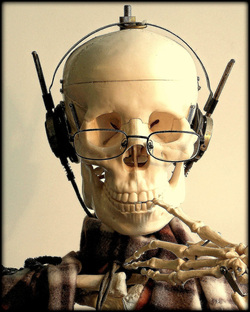The Skull

The skull is a very important part of the axial skeleton. Its primary purpose is to protect the brain, a vital organ within the nervous system. The skull is made up of two types of bones: cranial and facial.
Cranial Bones
There are eight cranial bones in the skull. Where the cranial bones meet there are immovable joints called sutures. Listed, below, are the eight cranial bones.
There are fourteen facial bones. The primary purposes of the facial bones are to shape the face and to allow movements such as chewing. The two major bone groups of the face are the upper and lower jaw. Listed, below, are the fourteen facial bones.
Cranial Bones
There are eight cranial bones in the skull. Where the cranial bones meet there are immovable joints called sutures. Listed, below, are the eight cranial bones.
- Ethmoid: This bone forms the lower part of the eye orbits, and the ceiling of the nasal cavity.
- Frontal: This bone forms part of the cranial cavity, including the forehead, brow ridges and nasal cavity.
- Occipital: This bone forms the posterior and inferior part of the cranium.
- Parietal (left and right): These bones form the superior and lateral part of the cranium.
- Sphenoid: This bone forms part of the eye orbits and the floor of the cranium.
- Temporal (left and right): These bones form the lateral part of the cranium and the external ear
There are fourteen facial bones. The primary purposes of the facial bones are to shape the face and to allow movements such as chewing. The two major bone groups of the face are the upper and lower jaw. Listed, below, are the fourteen facial bones.
- Lacrimal: These bones form part of the eye orbitals.
- Mandible: The lower jawbone. This bone forms the only movable joint in the head and allows the important movement of chewing.
- Maxilla (left and right): The upper jawbones. These bones also form part of the eye orbits, nose and mouth.
- Nasal (left and right): These bones form the upper portion of the bridge of the nose.
- Palatine (left and right): These bones form part of the nasal cavity and the back of the roof of the mouth.
- Turbinate (left and right): These bones form the lateral walls of the nose.
- Vomer (left and right): These bones form part of the nasal septum.
- Zygomatic (left and right): The cheekbones. These bones also form part of the eye orbitals.
